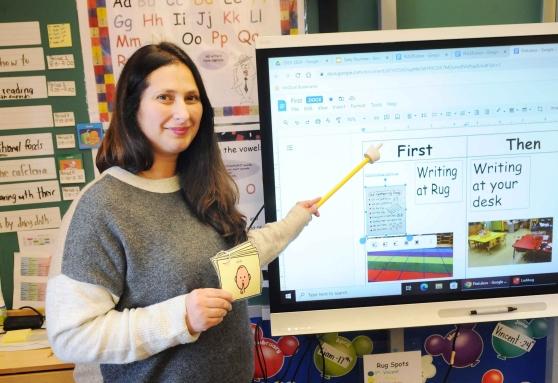
Monica Iacono, a teacher at PS 60 on Staten Island, demonstrates how she helps her kindergartners stay focused and on track.
Classroom management is the foundation of effective instruction. No one can teach a mini-lesson, administer an assessment or supervise independent work if students are inattentive or distracted (or worse, completely out of control).
New teachers may erroneously believe that effective classroom management comes from being stern and no-nonsense — “don’t smile until December,” for example, is a popular but misguided piece of advice. But veteran educators know that there are better ways to establish a calm learning environment.
Get to know your students. Good classroom management is built on good relationships. Monica Iacono, a UFT Teacher Center site coach and a teacher of kindergartners with autism at PS 60 on Staten Island, starts the school year by sending home an “interest survey.”
“You need to find out what motivates and engages kids,” she says. “Then you can develop positive rewards that appeal to their interests.” For a kid who’s crazy about dinosaurs, the promise of time with a dinosaur book might be hugely motivating.
Get buy-in. Schools and classrooms are communities, and all community members should have a say in how things are run.
“Ask your students, ‘What do we expect to do in the classroom? What do we need to do to make that happen?’” says Iacono. Write their responses on a chart in positive terms, such as “talk quietly,” rather than “don’t yell.” Regularly review these classroom expectations.
Natalie Sidarous, who teaches 4th grade ELA at PS 1 on Staten Island, frequently asks her students what they need to be successful. Students are more likely to stick to systems they had a hand in creating.
“We co-create expectations,” Sidarous says. For example, she let her students decide between keeping their reading logs in their notebooks or in their book baggies.
Establish routines. A visible schedule helps students anticipate what’s coming next. Iacono posts “First…then…” slides throughout the day, so her students always know where they should be with what materials.
Sidarous adheres to the “no surprises” philosophy of classroom management. “Discuss the schedule first thing in the morning,” she says. “And create a signal for transitions from one activity to the next” so students aren’t caught off guard.
She taught her 4th-graders a “switching gears” hand signal, which she uses to alert them when an activity is coming to an end. They respond by stopping what they’re doing and responding with the same hand signal, so she knows she has their attention.
Practice your routines. Rehearse, for example, the steps to pack up (step one: set your lunch box and homework folder on your desk; step two: get your backpack and coat from the closet, and so on) until students can do it smoothly. This rehearsal not only will prevent the classroom from dissolving into chaos, but it also transfers a certain amount of responsibility onto the kids, which is a critical element in building independence.
When you can, prepare for deviations from the routine. Kids who manage well in predictable circumstances can struggle when the routine is interrupted. For her kindergartners with autism, Iacono discusses the purpose of a fire drill and rehearses the process with her students so they aren’t thrown for a loop when the alarm sounds.
Figuring out classroom management takes a certain amount of trial and error. But these strategies should help you create and sustain an orderly learning environment in your classroom.